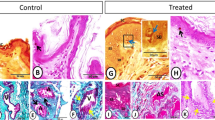Summary
The effects of testosterone on melanocyte number, morphology, melanin content and tyrosinase activity were studied in epidermis from several body regions of the black-pelted Long-Evans rat. Determinations were made in epidermal sheets processed for histochemical analysis by incubation in the presence of the melanin precursor, 3,4-dihydroxyphenylalanine (DOPA). Melanin content, cell volume, dendritic branching and tyrosinase activity of scrotal epidermal melanocytes all decreased progressively with time following castration. Daily testosterone injection, begun 14 days after castration, increased tyrosinase activity in 4 days, and dendritic branching in 6 days, of treatment; melanin content, cell volume and enzyme activity were restored to normal intact levels within 14 days of treatment, at which time newly synthesized melanin was evident in keratinocytes. The total number of scrotal epidermal melanocytes was not changed by castration or testosterone administration. Neither castration nor testosterone replacement affected any parameter of epidermal melanocytes in preputial, perianal or eyelid skin which, together with the scrotum, are the animals' only pigmented areas. Androgen control of epidermal pigmentation in the male rat is therefore specific for the scrotum and is manifested through regulation of melanin synthesis in stable populations of melanocytes rather than through increases in numbers of melanocytes.
Similar content being viewed by others
References
Baker, B. L., Johnson, G. E.: The effect of injections of Antuitrin-S on the sexually inactive male ground squirrel. Endocrinology 20, 219–223 (1936).
Bischitz, P. G., Snell, R. S. The effect of testosterone on the melanocytes and melanin in the skin of the intact and orchidectomized male guinea-pig. J. invest. Derm. 33, 299–306 (1959).
Bischitz, P. G., Snell, R. S.: A study of the effect of ovariectomy, oestrogen, and progesterone on the melanocytes and melanin in the skin of the female guinea-pig. J. Endocr. 20, 312–319 (1960).
Finkel, M. P.: The relation of sex hormones to pigmentation and testis descent in the opossum and ground squirrel. Amer. J. Anat. 76, 93–95 (1945).
Fitzpatrick, T. B., Breathnach, A. S.: Das epidermale Melanin-Einheit-System. Derm. Wschr. 147, 481–489 (1963).
Hall, T. C., McCracken, B. H., Thorn, G. W.: Skin pigmentation in relation to adrenal cortical function. J. clin. Endocr. 13, 243–257 (1953).
Hamilton, J. B.: The effect of male hormone upon the descent of the testes. Anat. Rec. 70, 533–541 (1938).
Hamilton, J. B., Hubert, G.: Photographic nature of tanning of human skin as shown by studies of male hormone therapy. Science 88, 481 (1939).
Jeghers, H.: Pigmentation of the skin. New Engl. J. Med. 231, 122–136 (1944).
Kuppermann, H. S.: Hormone control of a dimorphic pigmentation area in the golden hamster. Anat. Rec. 88, 442 (1944).
Laidlaw, G. F., Blackberg, S. N.: Melanoma studies. II. A simple technique for the DOPA reaction. Amer. J. Path. 8, 491–498 (1932).
Lyne, A. G., Chase, H. B.: Branched cells in the epidermis of the sheep. Nature (Lond). 209, 1357–1358 (1966).
McGuiness, B. W.: Skin pigmentation and the menstrual cycle. Brit. med. J. 2, 563–565 (1961).
Mills, T. M., Spaziani, E.: Hormonal control of melanin pigmentation in scrotal skin of the rat. Exp. Cell Res. 44, 13–22 (1966).
Pathak, M. A., Sinesi, S. J., Szabo, G.: The effect of a single dose of ultraviolet radiation on epidermal melanocytes. J. invest. Derm. 45, 520–528 (1965).
Quevedo, W. C.: A review of some recent findings on radiation-induced tanning of mammalian skin. J. Soc, Cosmetic Chemist 14, 609–617 (1963).
Quevedo, W. C., Smith, J.: Electron microscope observations on the postnatal “loss” of interfollicular epidermal melanocytes in mice. J. Cell. Biol. 39, 108a (1968).
Quevedo, W. C., Youle, M. C., Rovee, D. T., Bienieki, T. C.: The developmental fate of melanocytes in murine skin. In: Structure and control of the melanocyte (eds. Porta, D. G. and Muhlboek, D.) p. 228–241. Berlin-Heidelberg-New York: Springer 1966.
Snell, R. S.: Hormonal control of pigmentation in man and other mammals. In: Advances in biology of skin. (eds. Montagna, W. and Hu, F.) vol. 8, p. 447–466 New York; Pergamon Press 1967.
Snell, R. S., Bischitz, P. G.: A study of the effect of orchidectomy on the melanocytes and melanin in the skin of the guinea-pig. Z. Zellforsch. 50, 825–834 (1959).
Snell, R. S., Bischitz, P. G.: A study of the melanocytes and melanin in the skin of the immature, mature, and pregnant guinea-pig. Z. Zellforsch. 51, 225–242 (1960).
Staricco, R. J., Pinkus, H.: Quantitative and qualitative data on the pigment cells of adult human epidermis. J. invest. Derm. 38, 33–45 (1957).
Straile, W. E.: A comparison of X-irradiated melanocytes in the hair follicles and epidermis of black and dilute-black Dutch rabbits. J. exp. Zool. 155, 325–342 (1964).
Szabo, G.: Quantitative histological investigations on the melanocyte system of the human epidermis. In: Pigment cell biology (ed. Gordon, M.) p. 99–125. Academic Press, 1959.
Wells, L. J.: Seasonal sexual rhythm and its experimental modification in the male of the thirteen-lined ground squirrel. Anat. Rec. 70, 409–446 (1935).
Wilson, M. J., Spaziani, E.: The role of protein synthesis and tyrosinase activity in testosterone stimulated melanogenesis in scrotal skin epidermis. Unpublished results.
Wolff, K., Winkelmann, R. K.: Quantitative studies on the Langerhans' cell population of guinea-pig epidermis. J. invest. Derm. 48, 504–513 (1967).
Author information
Authors and Affiliations
Additional information
This work was supported in part by research grant no. HD 00446, and training grant no. HD 00152, from the Institute of Child Health and Human Development, Public Health Service.
Rights and permissions
About this article
Cite this article
Wilson, M.J., Spaziani, E. Testosterone regulation of pigmentation in scrotal epidermis of the rat. Z.Zellforsch 140, 451–458 (1973). https://doi.org/10.1007/BF00306672
Received:
Issue Date:
DOI: https://doi.org/10.1007/BF00306672




